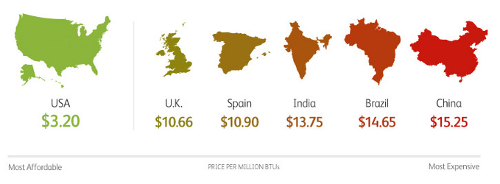
Most folks are largely unaware of the massive changes taking place in
the natural gas industry. We also have LNG proposals shaping up in
British Columbia as well. There is simply way too much gas available
for shipping to ever be absorbed by the USA market, while SE Asia is
learning to enjoy the benefits of gas. Thus it must be piped to the
coast.
Yet even with this wall of massive capital developments what
disquiets myself is that I know now where tomorrow's energy is coming
from and I can deliver it now.
Sooner or later that jam will break and all these plans must be dust.
Nikiski Saves
Alaska... and the U.S.?
By Keith Kohl |
Friday, July 11th, 2014
Nowadays, it seems
like every positive headline regarding our energy boom is coming out
of just two states: Texas and North Dakota.
Yet this only captures
a piece of the energy puzzle. Truth be told, it's about time there
was some good news elsewhere.
But the last place I
expected this news to come from was Alaska, where a
decades-long decline in oil production put the state into a
full-blown crisis.
Despite this, there's
no doubt that the Last Frontier State is still home to
tremendous reserves of oil and gas. And the state government has
always supported exploring for, drilling, and developing its oil
resources.
So recently,
Alaska's governor made an announcement that will have huge
implications for natural gas investors.
Before I get to the
news, let's first take a look at why Alaska's natural gas
resources hold more value than you might first think.
Between 2000 and 2010,
China quadrupled its natural gas consumption — and the figure
is still rising.
In the same time
period, India's natural gas consumption doubled. And after Fukushima,
Japan took the reins as the world's number one importer of liquid
natural gas.
The Japanese consumed
an astounding 37% of the world's LNG in 2012 to fill the gap left
behind after the shutdown of their nuclear reactors.
As demand from these
three LNG consumers surged, prices ballooned out of control...
Due in large part to
the shale boom, the U.S. has prices four times lower than in India
and five times lower than in China. Not pictured above is Japan,
where natural gas costs even more than in China.
In response to the
price discrepancy between Asian and American gas, our typically
anti-fossil fuel federal government made an unexpected move. As you
may know, the Department of Energy has been slowly — very slowly —
giving permits to companies that wish to export LNG.
In what would seem to
be contradictory policy, the EPA has also imposed new rules limiting
carbon emissions, effectively creating a bull market for natural gas.
But as these rules
take effect, and as we start exporting natural gas, demand here in
the U.S. will skyrocket as supply drops, resulting in higher energy
bills and a blunting of the manufacturing renaissance
Nikiski Saves Asia...
and the U.S.?
Last week, Alaska's
governor, Sean Parnell, received support from the state legislature
to invest millions of dollars in an 800-mile natural gas pipeline
that would stretch from the North Slope to LNG export plants to the
south.
This would expose
Alaska to the lucrative Asian LNG market without ending our
cheap supply at home. And that's not to mention that it could also
pad your portfolio if you play it right...
You see, after 40
years of tussling between regulators, environmentalists, and oil and
gas companies, Alaska will finally have a chance to avert its looming
energy crisis by developing its natural gas resources.
In his announcement, Governor Parnell said, “Real work is
beginning now on engineering, design, and environmental field work...
the state is now a full partner.”
Here is a map of
Parnell’s announcement — the linchpin for the future of U.S.
natural gas...
Nikiski is the planned site for a new major LNG facility, where
gas piped from Prudhoe Bay and Point Thomson will be refined and
shipped to Asian consumers desperate for cheap energy.
And thanks to the
Natural Gas Act, Alaska already has federal approval to
export its valuable resources to non-free trade countries all over
the world.
With Nikiski's Pacific
location, Japan and China will likely have first dibs on the North
Slope gas coming in the next few years.
As it stands now,
Alaska's North Slope is believed to hold an estimated 33 trillion
cubic feet of wet natural gas reserves...
This is great news for
Asian markets. Appliances, turbines, and furnaces in places like
Japan, Taiwan, and South Korea are specifically designed for
hotter-burning wet gas.
And this has the U.S.
and energy investors poised for a double windfall...
The bottom in domestic
gas prices will allow Alaska to take advantage of the record-high
prices in Asia without corrupting our cheap supply in the Lower 48.
This means
manufacturing companies that have been booming thanks to cheap
natural gas will continue to have their vital feedstock without
losing profit from price balancing.
So investors who
choose the right chemical companies, domestic gas drillers, and
soon-to-be exporters will find a fatter stock portfolio at their
disposal thanks to our dual-pronged natural gas plan.
If you aren't sure how
to invest your money following this announcement, my colleague
Christian DeHaemer has an extensive track record charting energy
prices in Asia. He even banked a 759% gain in 10 months on Petro
Matad...
And he has found some
potentially lucrative natural gas players that could surge once
Governor Parnell's announcement finds legs in the mainstream
financial press.
These aren't simply
natural gas drillers; the companies he found are going to see record
profits thanks to a special new bill designed by T. Boone Pickens
called HR1364, which is going to dramatically boost the demand for
natural gas in the U.S.
He and I both
recommend them highly, and we hope you enjoy your new wealth.

No comments:
Post a Comment